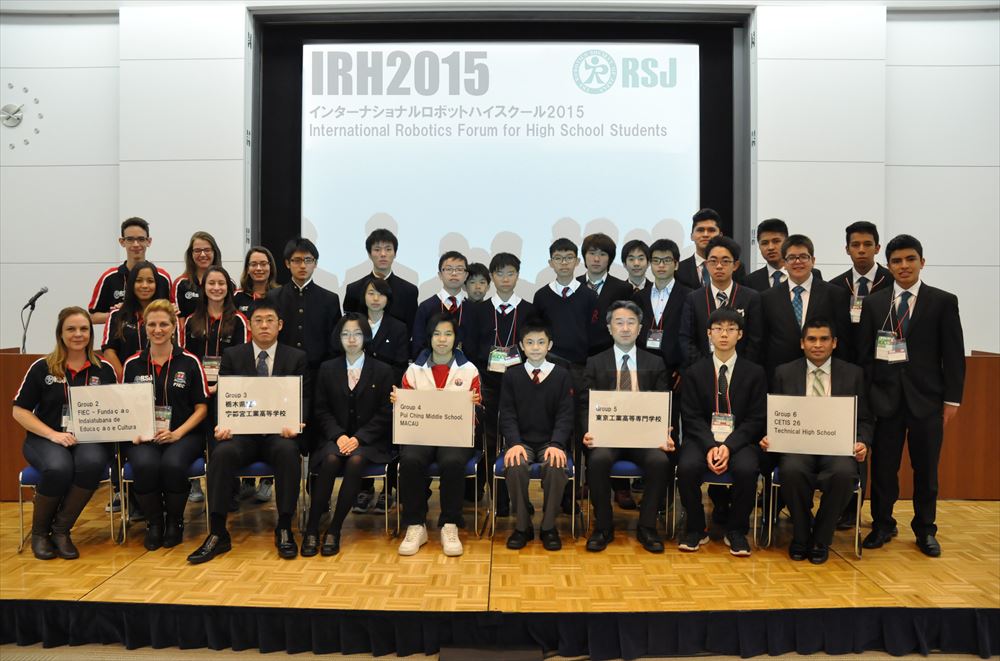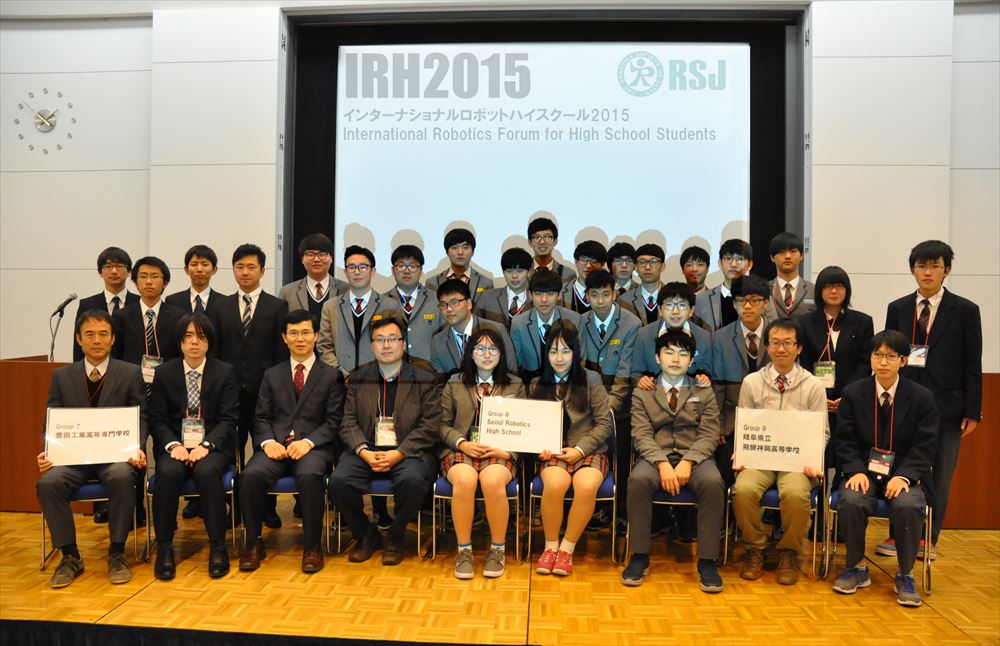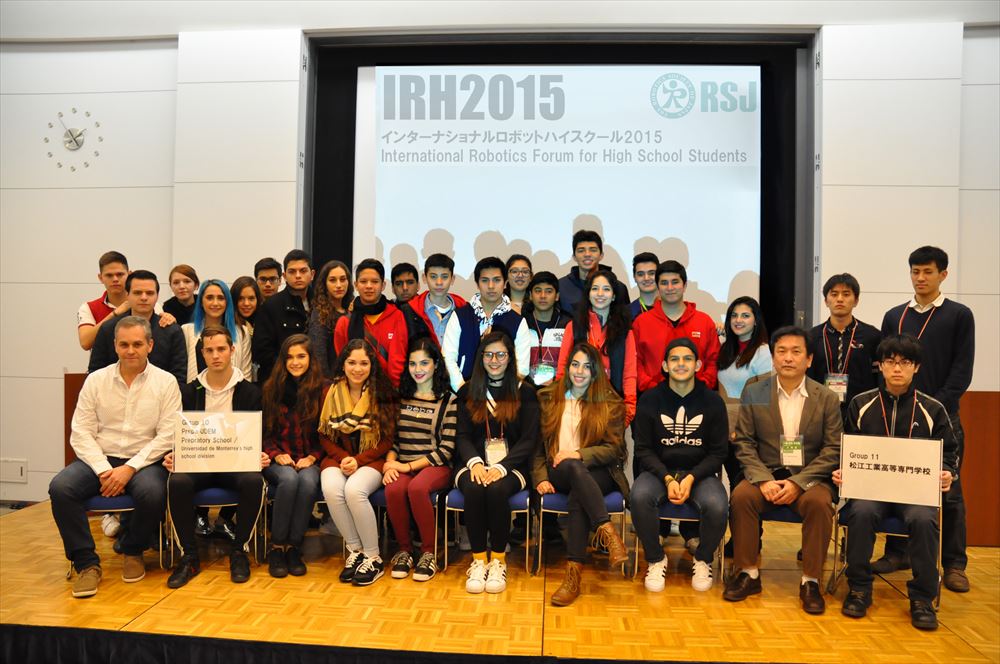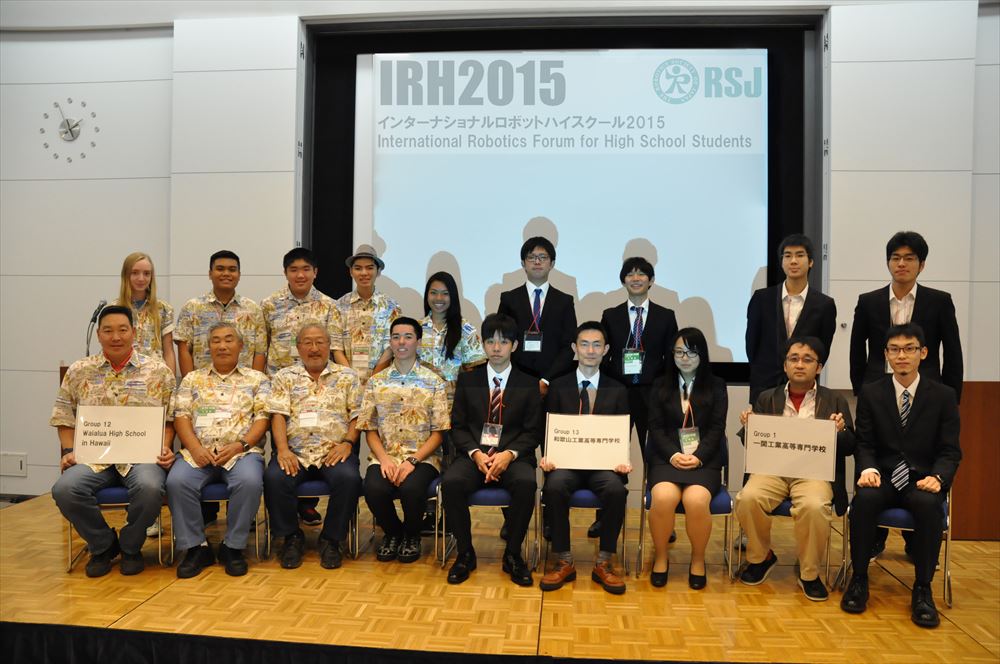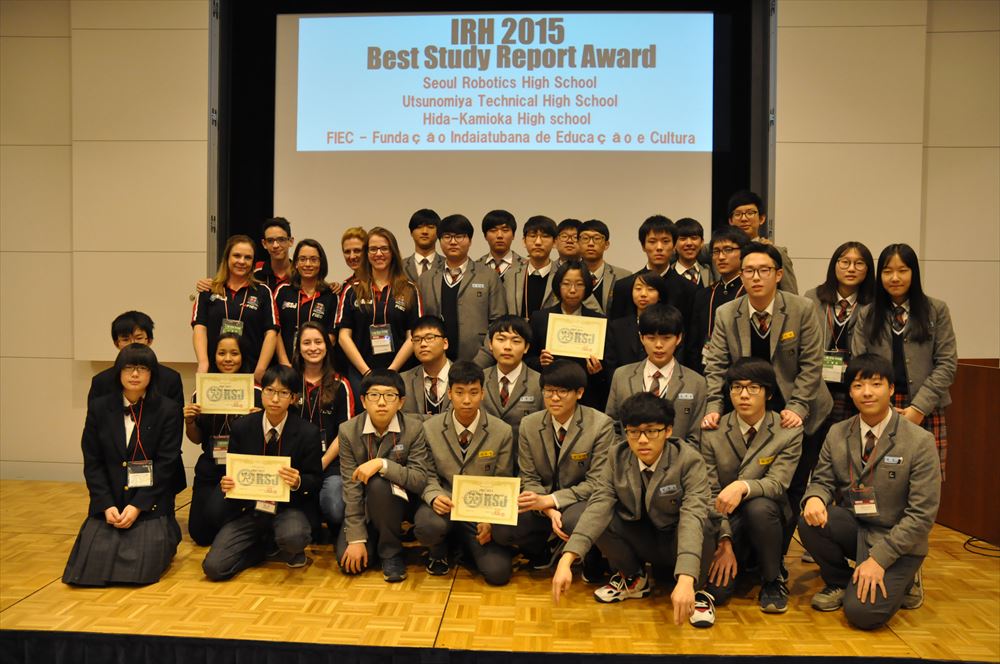Report of 2nd International Robotics Forum for High School Students (IRH 2015)
January 29, 2015
The Robotics Society of Japan (RSJ)
[Overview]
Sponsored by: The Robotics Society of Japan (RSJ)
Cosponsored by: Japan Robot Association and Nikkan Kogyo Shimbun Ltd.
Supported by: ROBOCON MAGAZINE,Ohmsha, Ltd. , HILS, Co. , Toyota Motor Co.,
Mitsubishi Electric Co., Yaskawa Electric Co.
Date: Friday December 4 and Saturday December 5, 2015
Date of open presentation: Saturday December 5, 2015, 10:00 ? 15:00
Venue: Tokyo International Exhibition Center, room 605 and room 606
Executive committee of IRH 2015:
| Chair: | Takashi Yoshimi, Vice president of RSJ, Shibaura institute of technology |
| Secretary: | Yuji Hosoda, Director and secretary-general of RSJ |
| Members: |
Tetsuo Noda, Mitsubishi Electric Co. Shinichi Hirai, Director of RSJ, Ritsumeikan University Okada Masafumi, Director of RSJ, Tokyo Institute of technology Shinya Kotosaka, Saitama University Riichiro Tadakuma, Yamagata University Sho Yokota, Toyo University Nobuyoshi Shimizu, Nikkan Kogyo Shimbun Ltd. Hideo Hayashi, Nikkan Kogyo Shimbun Ltd. Abe Saori, Nikkan Kogyo Shimbun Ltd. Shigeaki Yanai, Japan Robot Association Tomonori Yano, Ohmsha, Ltd. Motoko Takenishi, Ohmsha, Ltd. |
| Supervisors:: |
Norio Kodaira, Mitsubishi Electric Co. Hisashi Ohsumi, Chuo University |
Sponsor:  |
Cosponsor:  |
 |
Supporter:
 |
 |
 |
 |
 |
Purpose
Robotics educational project of RSJ for high school students in the world
Learning by lectures of basic robotics
Study and report of the International Robot Exhibition 2015 (iREX 2015)
Awards for outstanding presentations
Information sharing of robotics educational trial on each school and experience of international communication
Encourage of future robotics researcher and engineer
History
”Robot high school” that was an educational program for Japanese high school students using real industrial robot as learning resource were held in 2009 and 2011. These were corroboration with iREX 2009 and 2011.
1st International Robotics Forum for High School Students (IRH 2013) was hold as one of globalization actions in 2013 when IROS 2013 was hold at Tokyo. Number of participants was 109 and number of entrant schools was 19. 18 participants and 3 schools came from Norway, USA and China, and two companies supported this event.
RSJ had planned to held 2nd International Robotics Forum for High School Students (IRH 2015) as cooperation event of the International Robot Exhibition (iREX 2015).
Pamphlet of IRH 2015 is here.
Finally, number of participants became 113 and number of entrant schools was 13. 79 participants and 6 schools came from Brazil, China, Korea, USA and Mexico (two schools), and five companies supported this event.
Entrant school (You can refer introduction of each school with clicking the name of each school.)
Report
1. Schedule: Detail of schedule is here.
Friday December 4, 2015Lectures of basic robotics
Study of iREX 2015
Saturday December 5, 2015Open presentation; Study report of iREX 2015
Award ceremony
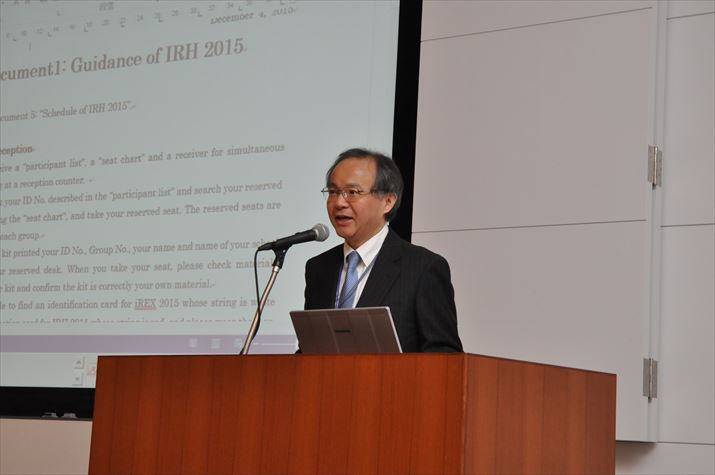 |
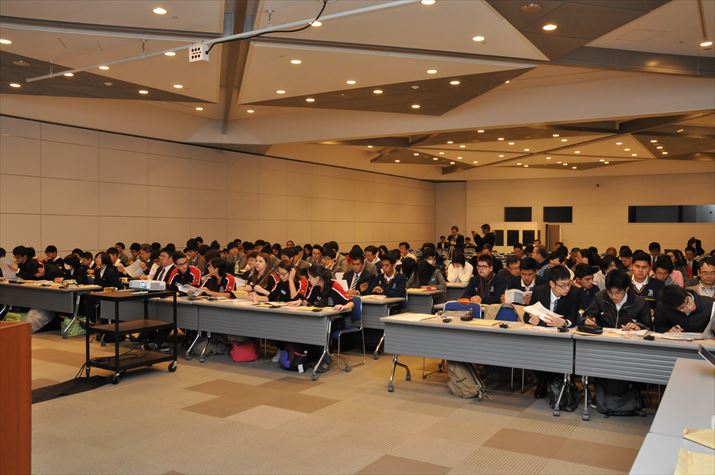 |
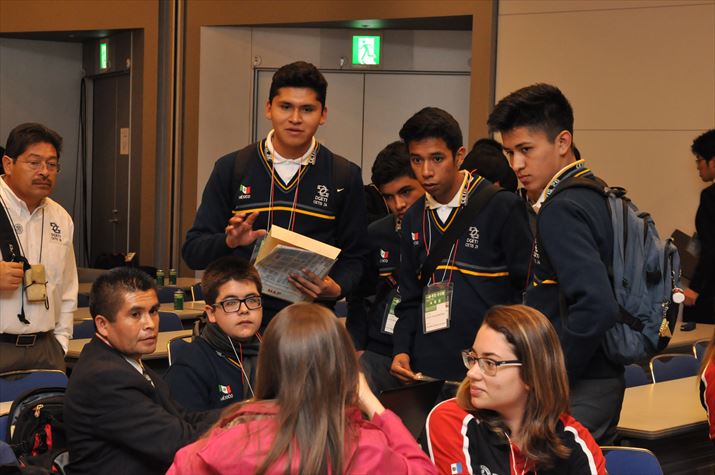 |
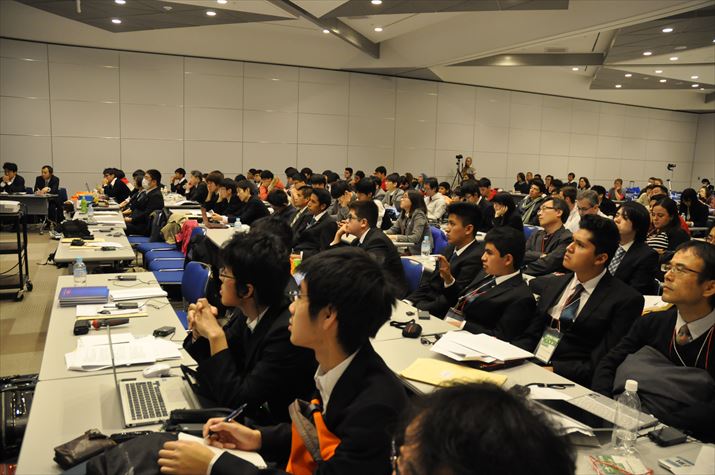 |
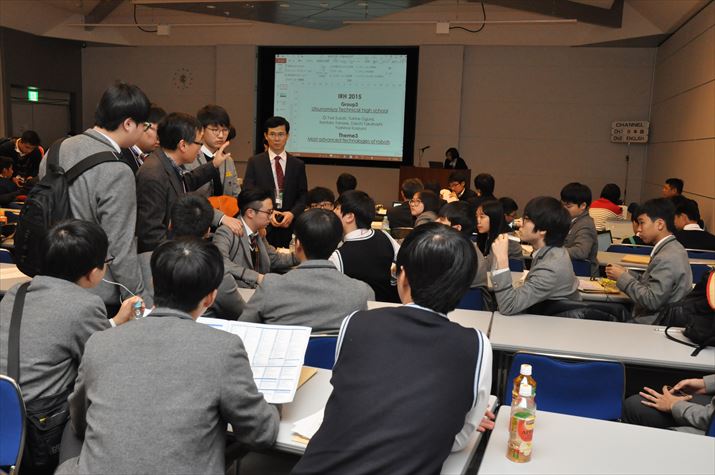 |
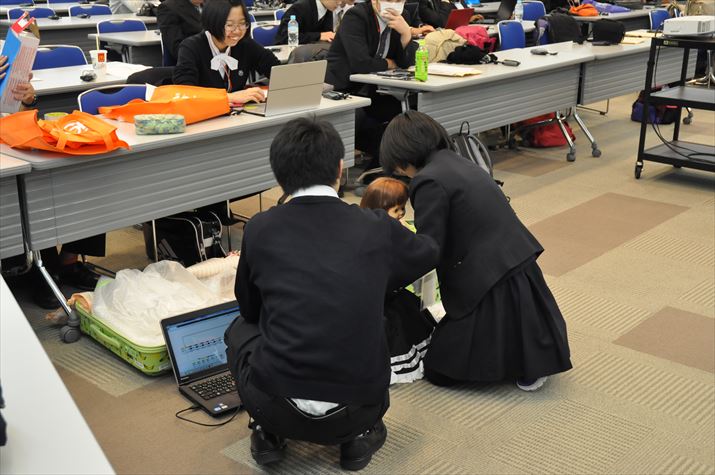 |
2. Lectures of basic robotics:
a) Lecture1: “Mobile Robotics; Technologies for the robots, which can move around the environment by itself”
(Presentation data of lectures 1 is here.)
Presented by Prof. Shin'ichi Yuta, the Shibaura Institute of Technology
Prof. Yuta who is an authority of autonomous mobile robot and education using real robot development lectured philosophy of development for practical robots that are useful in real world, and basic robotics. Moreover, he introduced Tsukuba challenge that is a trial experiment of autonomous mobile robot in the real world.
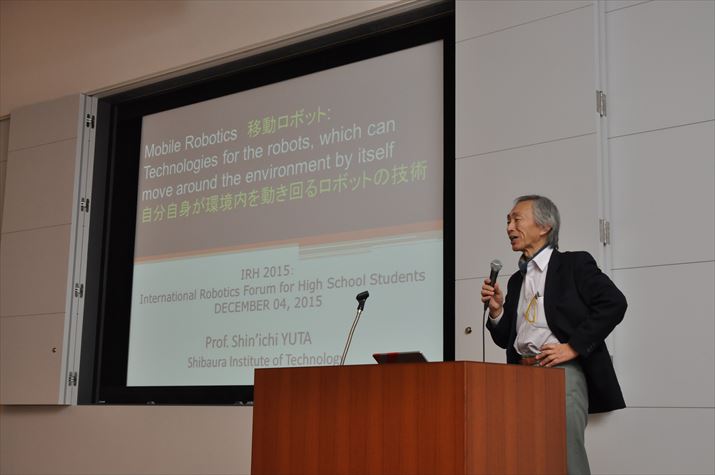 |
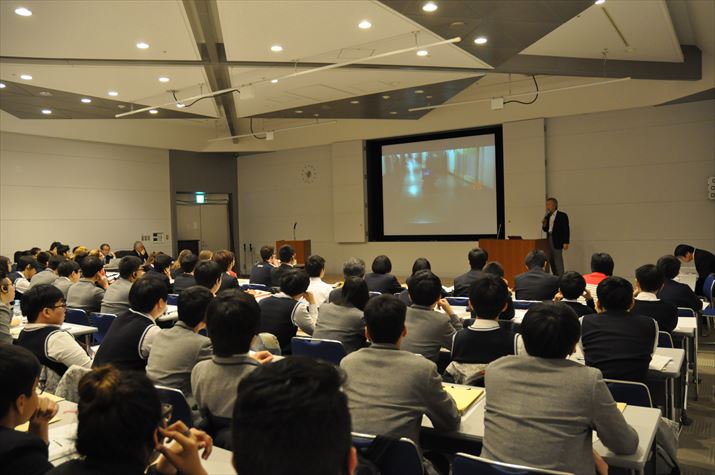 |
b) Lecture2: “An ABCs of Industrial Robot”
( Presentation data of lectures 2 is here.)
Presented by Mr. Kazuhiko Yokoyama, Yasukawa Electric Corporation
Mr. Yokoyama lectured basic technologies of industrial robots and development trends of industrial robots and service robots. Moreover, he reviewed topics and study points of iREX 2015.
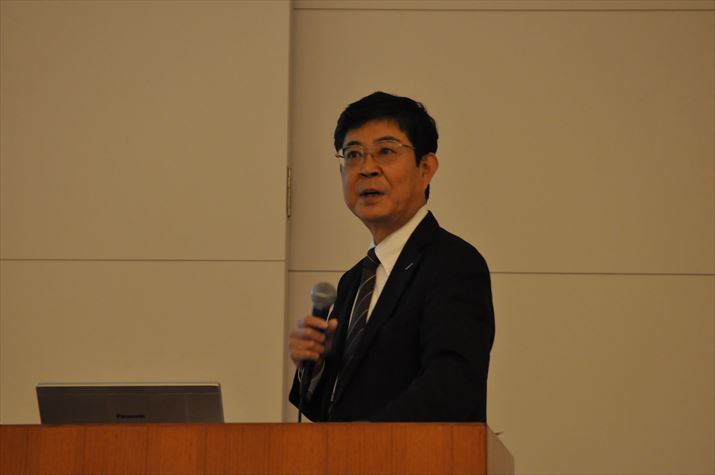 |
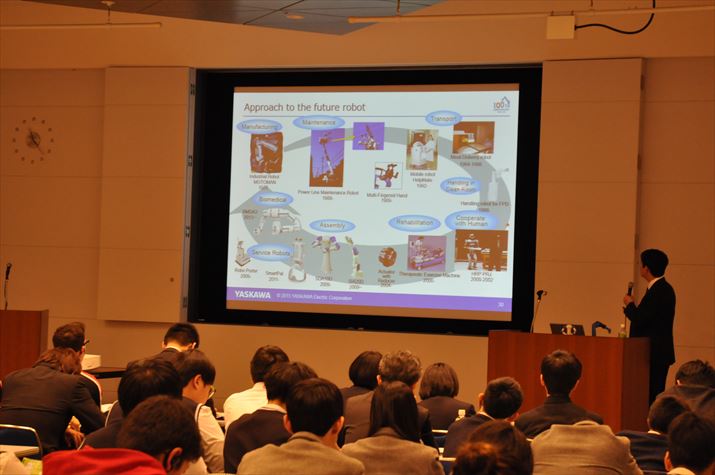 |
3. Study of iREX 2015 and themes of the study
All schools had done the study before IRH 2015 based on one theme that was selected by their self from following study themes. All students investigated real robots exhibited in iREX 2015 site in the afternoon of the Day One, and completed their study report that are presented at the Day Two open presentation with adding the result of the investigation.
<Field study at iREX 2015 site>
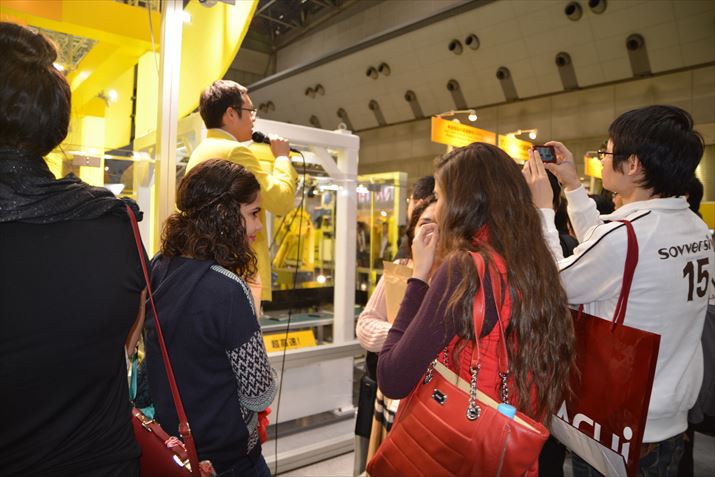 |
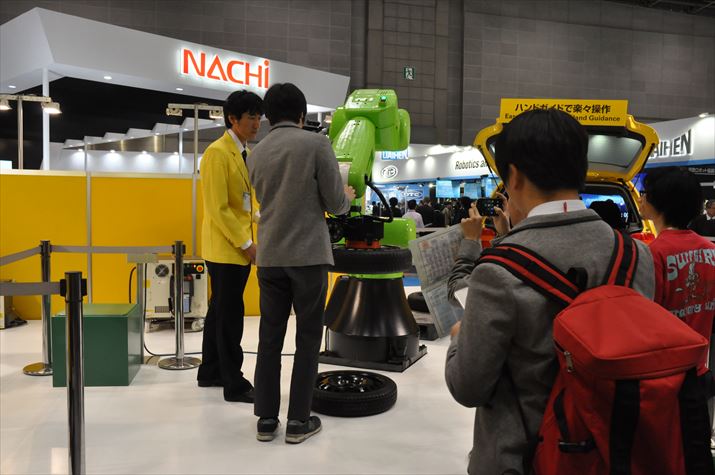 |
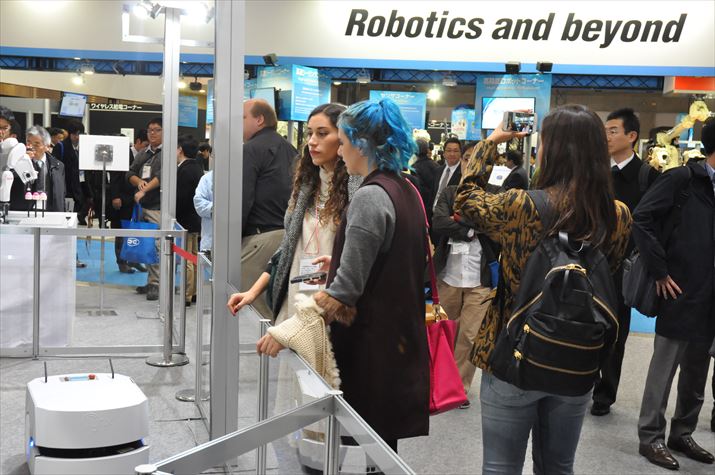 |
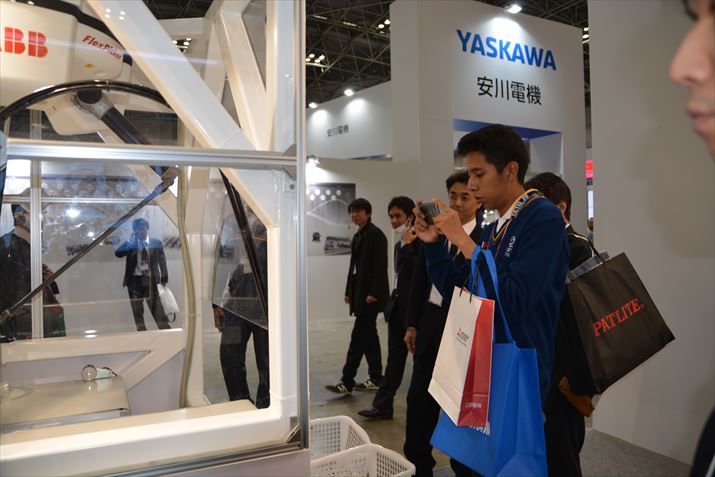 |
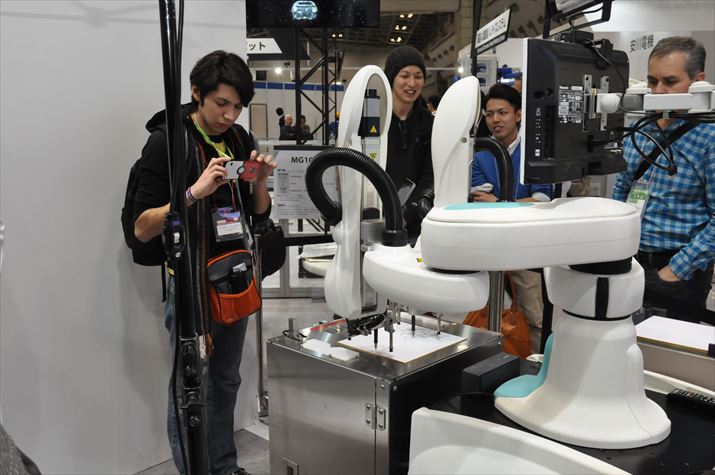 |
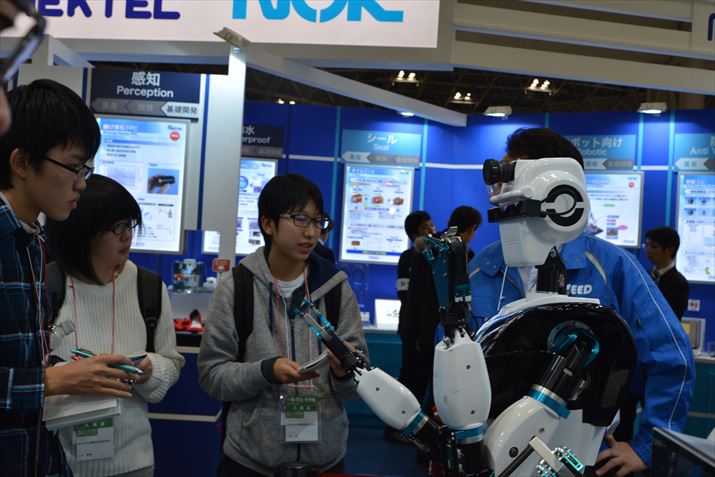 |
<Valuations of the study themes>
Theme 1: Systematization of fundamental technologies in industrial robots for manufacturing use
Aim of this theme is to learn fundamental technologies consisting industrial robots.
Please select one category from following three fundamental technologies in industrial robots for manufacturing use.
Please investigate variety of technologies, base principles and etc. included in the selected category, then classify and sort out the investigation results so as to clarify total image of the selected fundamental technology.
< Candidates of category selection>
1) Sensor technologies
2) Mechanical elements; e.g. actuators, reduction gears, structures, mechanisms, materials, and system constructions
3) Robot operating technologies; e.g. safety technologies, and system integration technologies
Theme 2: Relation between applications of robots and their performance
Aim of this theme is to learn design philosophies of robots optimized for its purposes and application environments.
Please select one category from following three robot applications, and investigate relations between robot applications and performances of robots; e.g. special features, functions, structures, constructions, and specifications.
< Candidates of category selection >
1) Manufacturing use; e.g. automobile, electric equipment, electronics components, medicines, cosmetics, foods
2) Service use; e.g. building cleaning, disaster response, infrastructure maintenance, security, medical treatment, care for old persons, agriculture, fisheries industry, amusements, guidance
3) Home use; e.g. floor cleaning, security, watch and guard for old persons, interactive home appliances, information terminals
Theme 3: Most advanced technologies of robots
Aim of this theme is to learn most advanced technologies of robots.
Please investigate the most advanced technologies for robots, and explain novelties, and/or usefulness of the technology, then how robots have been improved by the technology. If it is possible, please picture how the world will be changed by the robot evolution.
Technologies have some phases from basic research level to practical use level and there are individual most advanced technologies in the each phase as shown in following reference materials. First of all, please recognize the phase in which your focusing robot belong to. Then please investigate what is the most advanced technology in that phase.
< Reference material >
https://en.wikipedia.org/wiki/Technology_readiness_level
For a description of novelty, there is a way to state that it is solved the problems by a method which has not been used so far, the combination of principles, law, methods, individual way, or why there is a way to discuss whether now possible to use the way.
For a description of the usefulness, there is a way to argue that it has the same functionality at a lower cost, implementation of more functions at the same cost, functions which could not be realized until now although it cost more.
For changing the world, there is a way to discuss changes in the views of the site, the ways how people works, changes in lifestyle, changes in the common sense, expansion of the work efficiency by the robot, the effect of reducing the programming time and effort of the robot.
4. Open presentation
Open presentation was held at the room 605 and 606 on Saturday December 5, 2015.
Number of audiences was estimated 20; educators were 11, persons from companies were 7, and Individuals were 2.
Representatives of 13 schools presented their study. The presentation time of each school was 12 minutes, and all schools punctually finished in the limit time. Time of the field study at iREX site and preparation time for the presentation was limited in short time, however every students made excellent presentation.
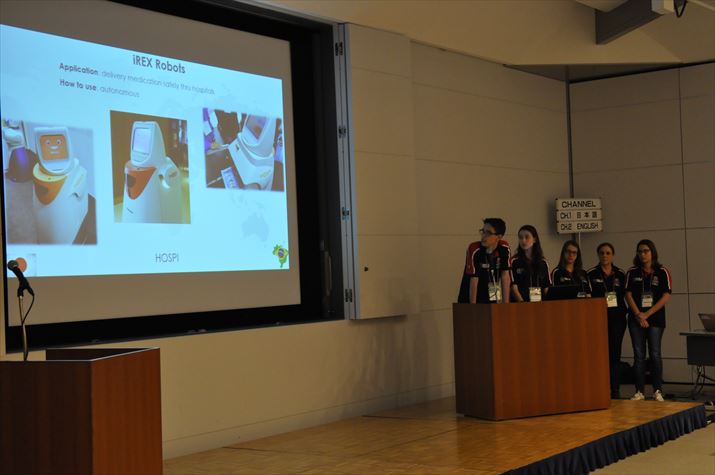 |
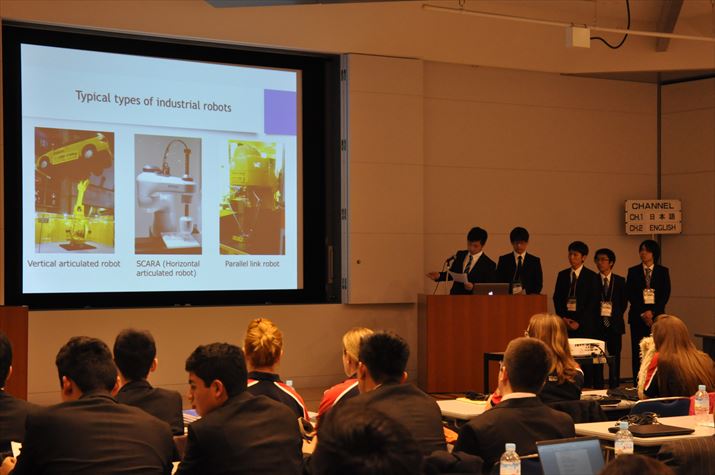 |
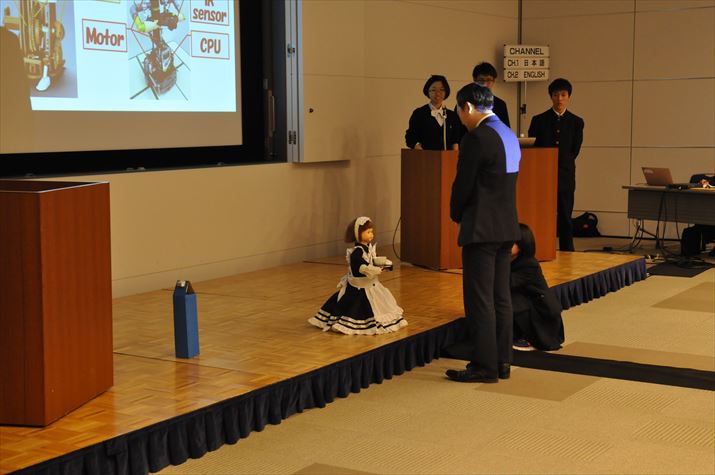 |
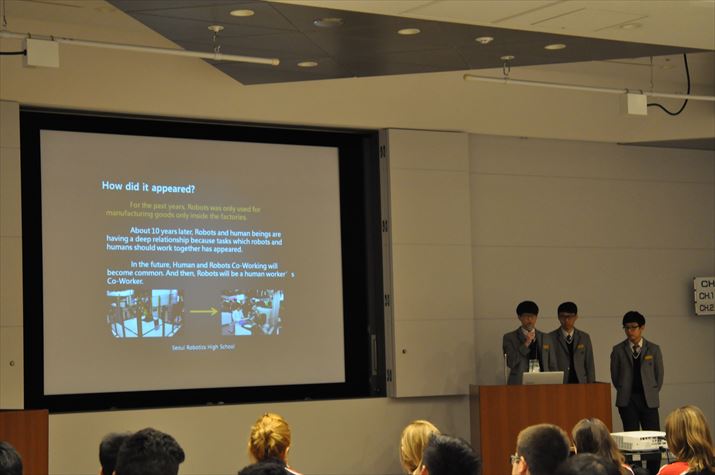 |
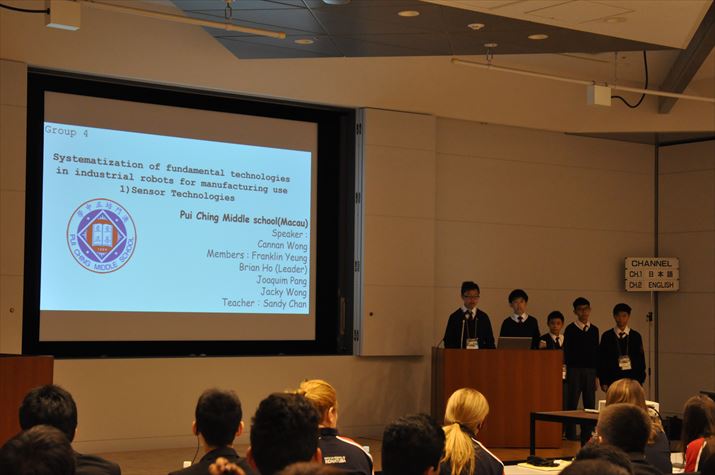 |
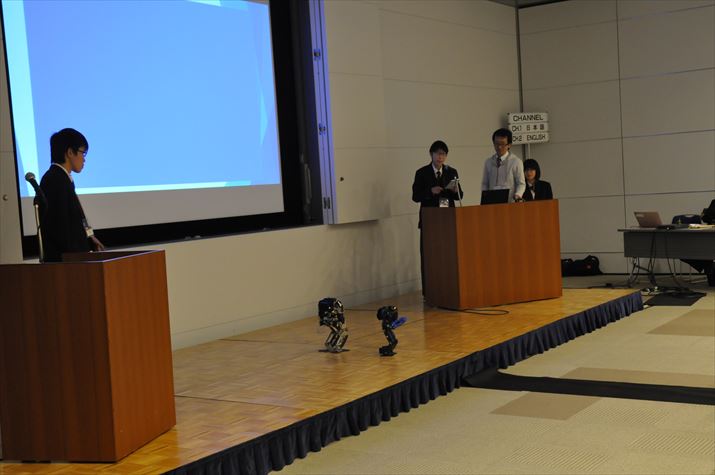 |
<Presentation data and selected study theme of each school>
| School name (Please refer the presentation data with clicking the school name) |
Selected study theme |
| National Institute of Technology, Ichinoseki College; Japan | Theme 1: Systematization of fundamental technologies in industrial robots for manufacturing use 2) Mechanical elements" |
| FIEC - Fundacao Indaiatubana de Educacao e Cultura; Brazil (1) FIEC - Fundacao Indaiatubana de Educacao e Cultura; Brazil (2) |
Theme 2: Relation between applications of robots and their performance 2) Service use |
| Tochigikenritu Utsunomiya Technical High School; Japan | Theme 3: Most advanced technologies of robots |
| Pui Ching Middle School, MACAU; China | Theme 1: Systematization of fundamental technologies in industrial robots for manufacturing use 1) Sensor technologies |
| National Institute of Technology ,Tokyo College; Japan | Theme 2: Relation between applications of robots and their performance 2) Service use |
| CETIS 26 Technical High School; Mexico | Theme 1: Systematization of fundamental technologies in industrial robots for manufacturing use 1) Sensor technologies |
| National Institute of Technology, Toyota College; Japan | Theme 2: Relation between applications of robots and their performance 1) Manufacturing use |
| Seoul Robotics High School; Korea | Theme 1: Systematization of fundamental technologies in industrial robots for manufacturing use 3) Robot operating technologies |
| Hida-Kamioka High school; Japan (1) Hida-Kamioka High school; Japan (2) |
Theme 3: Most advanced technologies of robots |
| Prepa UDEM Prepratory School; Mexico | Theme 2: Relation between applications of robots and their performance 2) Service use |
| National Institute of Technology, Matsue College; Japan | Theme 2: Relation between applications of robots and their performance 3) Home use |
| Waialua High School in Hawaii; USA | Theme 3: Most advanced technologies of robots |
| National Institute of Technology, Wakayama College; Japan | Theme 3: Most advanced technologies of robots |
5. Awards ceremony:
a) Following four schools were selected as outstanding presenter from all 13 presentations of the “Study report” and RSJ presented them “IRH 2015 Best Study Report Award”.
|
Seoul Robotics High School; Korea Utsunomiya Technical High School;Japan Hida-Kamioka High school; Japan FIEC - Fundacao Indaiatubana de Educacao e Cultura; Brazil |
* Click to enlarge |
b) ”Testimonial for Study Report of IRH 2015” was presented to all teachers with regarding their excellent leading of their students.
c) “Certificate of IRH 2015” was presented to all participants.
d) General comment:
We assessed the presentations to select award winners. However, all presentations were excellent and level difference between all presentations was negligible. All speakers were exactly punctual to the presentation limit time with well controlled speaking. Attitude, utterance and manners of presentation might be better than those of university students in many conferences. Though the preparing time of pre-study and investigation time in iREX 2015 wasn’t so enough, all study contents were brushed up well and all presentations were well summarized and easy to understand. We believe that these excellent presentations depend on daily student’s effort and good leading of teachers. We would like to give honor to their great activity.
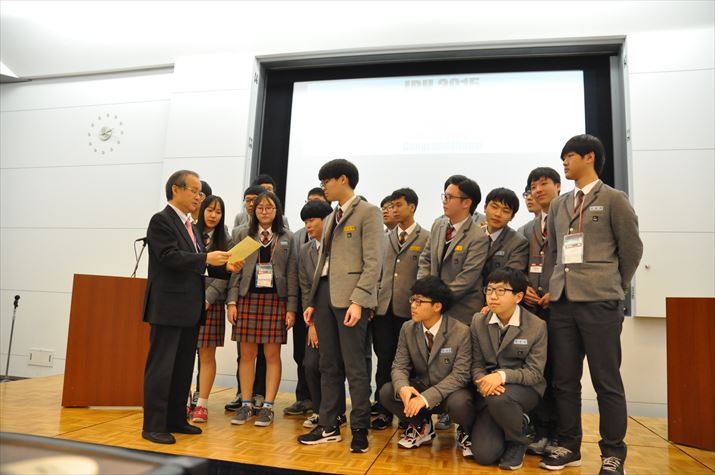 |
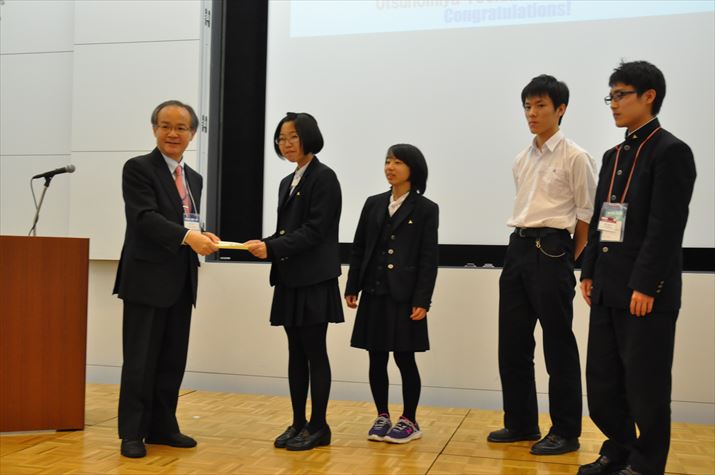 |
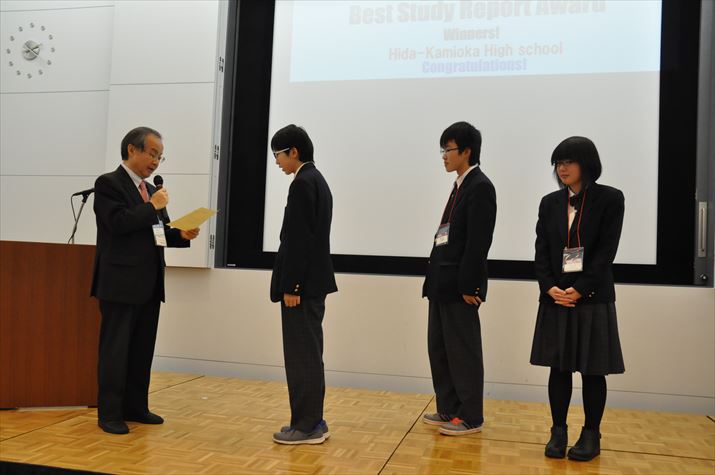 |
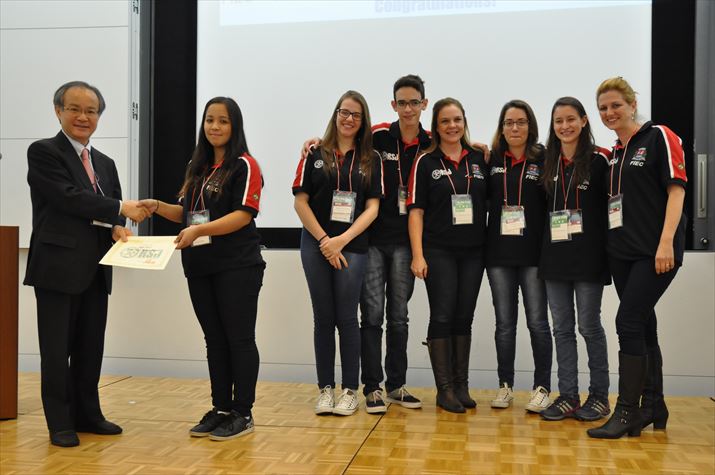 |
